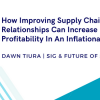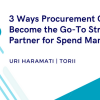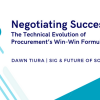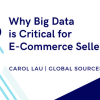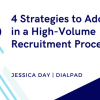Another rainy trip up north, I thought to myself, turning on the windshield wipers. A recent phone call from Anne, the head of global purchasing, requesting my participation in reviewing some ideas to build stronger partnerships with their inside-outsourcing service providers (IOSPs), was the reason for the trip. Over my forty years as an IOSP, I’d become very cynical and prejudicial towards purchasing departments. As an IOSP to the auto industry, I’d witnessed countless purchasing initiatives resulting in bankrupting IOSPs due to a complete lack of foresight.
Often I’d joke with colleagues that those who chose to be in purchasing were actually from another planet, spoke a completely different language, and used their own dictionary. We’d go into sessions and talk about value add, but purchasing heard lower invoice cost. We’d discuss collaborating, and they heard dictating. We’d say competitive, and they heard low-cost. Over the decades, relationships between IOSPs and Purchasing became increasingly strained. Initiatives such as target pricing slowly eroded any level of trust or loyalty. The recent phone call from Anne, however, was different. The tone was different. The arrogance normally present was replaced with a level of humility, a real sense of gratitude for my agreeing to make the trip and spend time with her team.
I pulled into the visitors’ lot, grabbed my bag, strode through the lobby, and signed in with security. In minutes Anne herself met me, and escorted me to a small conference room to meet her team.
“I’d like to introduce you to Dean, my nemesis,” Anne said, offering me a seat at the table in the middle of the group.
“Good morning. I’m Mandy, our contracts administrator.”
“Pleasure to meet you. I’m JP, our contracts engineering liaison.”
“I’m Ben, the indirect purchasing specialist. We’ve heard a lot about you from Anne.”
“Nemesis?” I asked, looking at Anne.
“Yes. You have always provided me with a rival perspective over the years, which is the reason I sought you out to help us today,” Anne replied, taking her seat.
“We’re in trouble with our inside-outsourcing service providers. Specifically, we are struggling with getting them to be our partners,” Mandy said, eyeing Anne as she spoke.
“Dean, you’ve been around too long to sugar-coat the issue. We’ve managed to lose the loyalty of our IOSPs. We cannot even get them to approach us with new ideas or solutions, and we’re hoping you can help us see their perspective,” Anne stated in a pretty solemn tone, making eye contact with each member of her team.
“We prepared a presentation for you outlining key performance metrics and how our IOSPs stack up against those metrics,” JP said, as Ben opened up his laptop to project their charts and graphs on an overhead screen.
“JP, I’m sure your presentation is very good, but I think you need to take a step back and consider the one troubling thing I’ve heard so far. Your IOSPs are avoiding you. Is that accurate?” I asked.
“Very accurate,” Ben exclaimed.
“Then your solutions start with that problem. What you probably don’t want to hear is that the fix will take time. You did not lose the trust and loyalty of your IOSPs overnight and you will not get it back overnight, but you can get it back,” I said, surveying the room for comprehension.
My mind wandered to an article I’d read in the Neuro Leadership Journal by David Rock. In the article, he’d simply laid out a model to encourage collaboration. I’d worked with this company as a customer for decades and knew their love of models. I felt this might be the best path forward in today’s situation.
“We can’t argue your point. We actually came to a similar conclusion ourselves, but we need your help for us to understand how these service providers think,” Anne said, receiving nods of agreement from her team.
“I recently read an article which resonated with me. I think it will give you a framework to resolve your problem. Let me start by asking, why do you outsource the management of your facilities to service providers in the first place?”
“To reduce cost,” JP quickly replied.
“Cost is important for sure, but we also need a level of expertise that we just do not have in-house,” Ben added.
Mandy chimed in, “I agree with cost and expertise, but we also need someone who will focus on non-core areas, allowing us to focus on building cars.”
“I agree with what you all said, but frankly we really suck at it. Our internal cost to perform the work ourselves was out of control, and we were not able to internally rein it back in,” Anne said, staring directly at me and conveying a very strong sense of transparency.
“Okay, very honest response. You are looking for a service provider to accomplish what you cannot, at a competitive cost, who brings a level of expertise to the table, and focuses on innovating how you manage your facilitates. Do I have this right?” I asked.
“Perfectly put,” Mandy said.
“As I service provider if you came to me and shared what I just heard, I would feel honoured to be chosen to help you. You would inevitably increase my status as an expert service provider.”
“We’ve done that with little to no improvement,” Ben said.
“Did your commercial arrangement align with your message, or did your commercial arrangement follow a strict, out-of-date scope, advising your IOSPs to put numbers in cells of a spreadsheet next to each activity line?” I asked.
“Not quite as bad as you make it sound, but in theory you’re right,” JP said, jotting down a note.
“So on the one hand you build up the status of the IOSP, and your RFQ tears it back down, making the IOSP feel subservient and not the expert you are looking for,” I stated.
“Am I to assume status is the first part of this model?” Anne asked.
“Absolutely. If you want experts to innovate, you need to treat them as such and keep treating them as such if you wish them to approach you with new ideas,” I said
“I can see where we missed this and where our current commercial model also misses this,” Mandy said.
“The next step on the path is to provide some level of certainty to your IOSPs. Please don’t take this the wrong way, but your past practices were to keep your IOSPs on their toes by threatening them with the loss of business. Is that still the rule of thumb, or has it changed?” I asked, staring at Anne.
“It’s changed corporately, but we’re still fighting that issue at the local plant level. On some of the data JP wanted to show you, you’d see how IOSPs alter their pricing based on the geography of the site and not the volume of activities being outsourced. That led us to believe and understand they wish to avoid working at those sites, and those sites have also turned over more IOSPs than other sites,” Anne said.
“Excellent observation. When there is a lack of certainty in a business 100% reliant on people, you are going to have a problem. IOSPs need to know that if they meet the goals, they have a future with you.”
“So a level of certainty is the next part of the model?” Ben asked.
“Absolutely, followed by a level of freedom to be the expert. If you want experts, you must allow them to be experts. In many cases, IOSPs are forced to take direction from people on your staff who are not experts but who think they are. This leads to a lack of autonomy for the IOSP, and they need autonomy. It is a key driver for them to bring you new innovative ways of performing services.”
“So the next step is autonomy. We hire experts, we ensure a future, and we give them the freedom to be experts. I’m having a ‘duh’ moment,” Ben said.
“You’re not alone,” Anne retorted.
“The fourth part is the one nearest and dearest to my heart. Your IOSP needs to relate to why you are outsourcing this work in the first place. The purpose needs to be made very clear, and desired outcomes must be documented with measurable success factors,” I stated.
“Won’t that hurt their status?” Mandy asked.
“No. You are not telling them how to do the work. You are telling them why you need them and what you need them to do. As you progress, you can invite them to help you define what you need done to improve your desired outcomes. The more you do this, the more they will relate to you. The more autonomy you give them actually increases their status.”
“What a different way to think!” JP exclaimed.
“Macro versus micro managing?” Ben threw out to the group.
“We’ve been sewn into a rut of operating transactionally and not focusing on the bigger outcome, the real value associated with well ran facilities services,” Anne said to the team.
“Is that it?” JP asked.
“Not quite. You must realise IOSPs are in business to make money – a reasonable and fair return on their investment. If you continually chase IOSP’s costs to you, what you are invoiced, at some point you hit a point of diminishing returns. The service business is 90% plus people costs, and your IOSPs can only provide you with improvements if they’re able to engage their people. In the past you dictated bill rates that were poorly investigated and resulted in poor-calibre talent being placed into your facilities, and here you are today wondering why no one approaches you with innovative ideas,” I said.
“We reaped what we sowed. We understand that, Dean,” Anne said.
“The final piece of this conundrum to collaboration is to be fair. Let it be known you are looking for your IOSPs to make a fair return on their investment. It is not fair for you to assume they are making a killing and the money they make is yours. The money they make is theirs. It is their return for managing an innovative, efficient service business. Allow them their profit, and seek out value.”
“This mindset is aligned with where we want to go. You have presented it in a concise manner, something we can model. Our struggle is the starting point. The portfolio of what we outsource to our IOSPs is extremely large,” Anne said.
“Anne, you need to change how you are viewed. Identify the IOSP you trust, one with history, with the right culture, and seek their help to run a pilot.”
“Then what?” JP asked.
“Then you do it again. So one site becomes two, two becomes four, four becomes eight, and so on. During this time you’re proving to your IOSPs that you really are a partner. You respect their status, you provide them certainty, give them autonomy by allowing them freedom to run their business, ensure they relate to your true needs, and be fair with them. A decade from today you will have what you once had, a loyal group of IOSPs dedicated to improving your competitive advantage,” I said in summary, glancing at the clock.
“Time does fly when you’re having fun! We are just about out of time,” Anne started to say, just as JP chimed in.
“We can’t wait a decade.”
“We already did,” Ben pointed out.
“Good point. Maybe even two decades,” Mandy said, looking towards JP.
“The key is to run the pilot, build your confidence and that of your chosen IOSP, and develop a tipping point where trust and loyalty are foundational to your business dealings, and not fear,” I said.
“Dean, let me express our sincere thanks, and let me walk you back down to security,” Anne said, getting up from her chair.
As I walked down with Anne, she again thanked me for the time, and I began to believe that possibly those in purchasing did not come from another planet, and with continued support we could improve our vernacular and all define value in the same manner.



